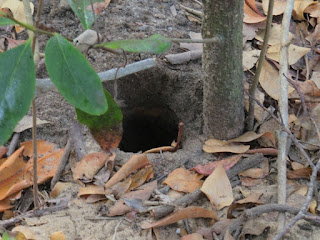Some of the subjects
I would like to write about take years to track down. Finding out
about them was like solving a mystery where I get one clue at a time.
Nocturnal animals in particular fit into this category as finding
them and learning about their habits can be very difficult. Sometimes I do
not know which animal makes the signs that I am observing so it is
very hard to organise the clues I am observing into records. For
this reason, special attention needs to be be given to recording
animals which are rarely directly observed. I am writing my own software
to make the task of piecing such information together easier. It was
actually the creature described below that gave me the idea to do so.
Not far from home
and close to the path to the beach, I found two large burrows that
were much larger than usual and I had no idea what creature made
them. Each time on my way past, I would watch the holes for signs of
life. Just once, I saw a stilt mangrove dropper slowly disappearing
down the hole, so now I new what it ate. One day the hole was closed
over and remained so for all of the cooler months, reopening only
quite late in the year. A second year passed without laying sight on
the creature. The hole closed over again. I bought an inspection
camera with a 7 m cable and eased it down the hole. Without the
ability to steer the camera, it quickly buries into the sandy side of
the twisting tunnel and no images were forthcoming. I resisted the
urge to just dig the creature up. In late 2015, I caught my first
glimpse of the creature, a huge black boxy crab about 15 m from
me-too far to see any detail. Gradually, I eased out of the crab's
view and ran to grab a camera but the crab was gone when I returned.
A few months passed and I was just walking to the beach and cast a
glance in the direction of the holes and there it was. This time, I
stood frozen, which induced the crab to freeze and I asked someone
else to run for the camera. In the weak light of late afternoon and
with a superzoom camera at full length, I finally got enough detail
to find out what this creature was. It was a giant oceanic land crab
(Cardisoma carnifex), which can be 125 mm across the
carapace – making it the second largest crab in the mangroves after
the mud crab.
 |
| Repairing burrow after heavy rain. (Click to enlarge) |
 |
| Same crab - close up. |
There was no record
of this species on the Australian mainland in the Atlas of Living
Australia, although there is a brief description of the species being
present in a book on crabs by by Peter Davie at Queensland Museum so
they are known from the mainland. It is certainly not common.
Despite searching similar habitats through the area, I found no other
similar holes although I did have some near misses with some very
large feral pigs whilst exploring some remote backswamps. Apparently
these crabs are present in select places around the Cairns/Port
Douglas area. I had privilege of claiming the first mainland entry
into the Atlas of Living Australia!
The species is one
of the dominant life forms on many Pacific and Indian Ocean Islands,
where they are an important source of food for local peoples (Lairo
seems to be the recognised common name). Yet despite its importance,
very little accessible information is available about its ecology.
Some additional information is available from the following link. http://www.oocities.org/ericdemuylder/gecarcin.htm
Update February 2016
Two years ago, there was single crab hole, last year there were two holes becoming three by the end of the year. Now there are twelve holes in the colony. I am pretty sure that the crabs have only a single hole as sometimes I see the crab above at its nearest neighbour as the same time. I have not found any other colonies, even in places where the crabs have been reported by others.
Update February 2016
Two years ago, there was single crab hole, last year there were two holes becoming three by the end of the year. Now there are twelve holes in the colony. I am pretty sure that the crabs have only a single hole as sometimes I see the crab above at its nearest neighbour as the same time. I have not found any other colonies, even in places where the crabs have been reported by others.

No comments:
Post a Comment